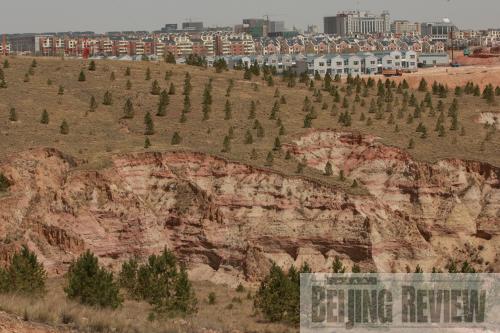| 
Before 2002, Liu Fenghai often struggled to squeeze enough sustenance from his farm in Talahao, Inner Mongolia Autonomous Region, to feed himself and the other three members of his family. His land was hard and often yielded little.
That was before the region's government implemented an "ecological resettlement" strategy, transferring those farmers and herdsmen living in infertile areas to places where food could grow bountifully. Under the plan, Liu and his family moved to a new plot of land in 2002.
"From then on, my family started to plant sea buckthorns with help from the government," Liu told Beijing Review. "In 2007, we earned more than 7,000 yuan ($1,024.89) from planting sea buckthorns and in 2008, we earned more than 15,000 yuan ($2,196.19)."
The government also gave subsidies of 180 yuan ($26.35) per hectare in 2007, which were raised to 210 yuan ($30.75) a hectare in 2008, Liu said.
Of Inner Mongolia's 1.18 million square km of land, 48 percent is desert and another 48 percent is areas of sand gullies. Only 4 percent of the total is conducive to human settlement.
Sea buckthorn is an undomesticated plant that grows in sandy soil at an altitude of 1,200-4,500 meters (4,000-14,000 feet) in cold climates. It is especially suitable to grow in areas dominated by sand gullies.
As a region along China's dry northern border, the prevention and control of desertification, a kind of degradation of land in arid and dry sub-humid areas caused by natural activities and climatic variations, has always been a primary concern of the government, said Hu Qun, Deputy Director of the Inner Mongolia Forestry Administration.
Hu said governments at various levels in Inner Mongolia have encouraged farmers and herdsmen to grow all kinds of sand-friendly plants like sea buckthorn in the past to control desertification. The plants naturally anchor soil to the ground and slow down the drift of loose sand. However, survival rates were always low because of the harsh climate, making it difficult for farmers and herdsmen to see the benefit in growing the plants.
"Facing such a situation, we were thinking how to use these sand plants to provide for farmers and herdsmen. We finally got the answer--developing the sand industry," said Hu.
Hu said the government has offered incentives such as preferential taxing policies and provided research fees to encourage businesses to exploit the economic possibilities of sand plants. In this way, enterprises can profit from the industry along with local farmers and herdsmen.
A bold concept
In the late 1990s, sandstorms became more frequent and brought bigger threats to Beijing's environment. In response, the Chinese Government launched the largest program in history to control desertification. And as one of the main sources of sandstorms, Inner Mongolia became a focus of the effort.
After years of management, the expansion of Inner Mongolia's desert has come under control and the situation has turned around, Hu said.
Data from the Inner Mongolia Forestry Administration show that forest coverage will increase to 20 percent by 2010 and 23 percent by 2020 compared to its current 17.6 percent. Then Inner Mongolia will be a
"natural green protective screen" in north China, Hu said.
| 